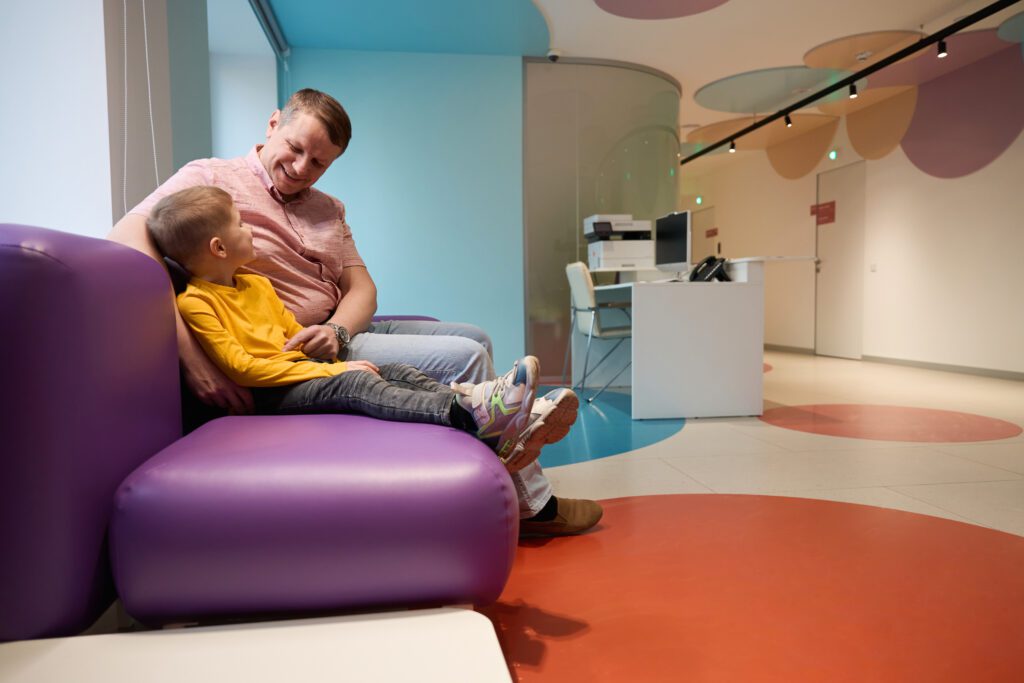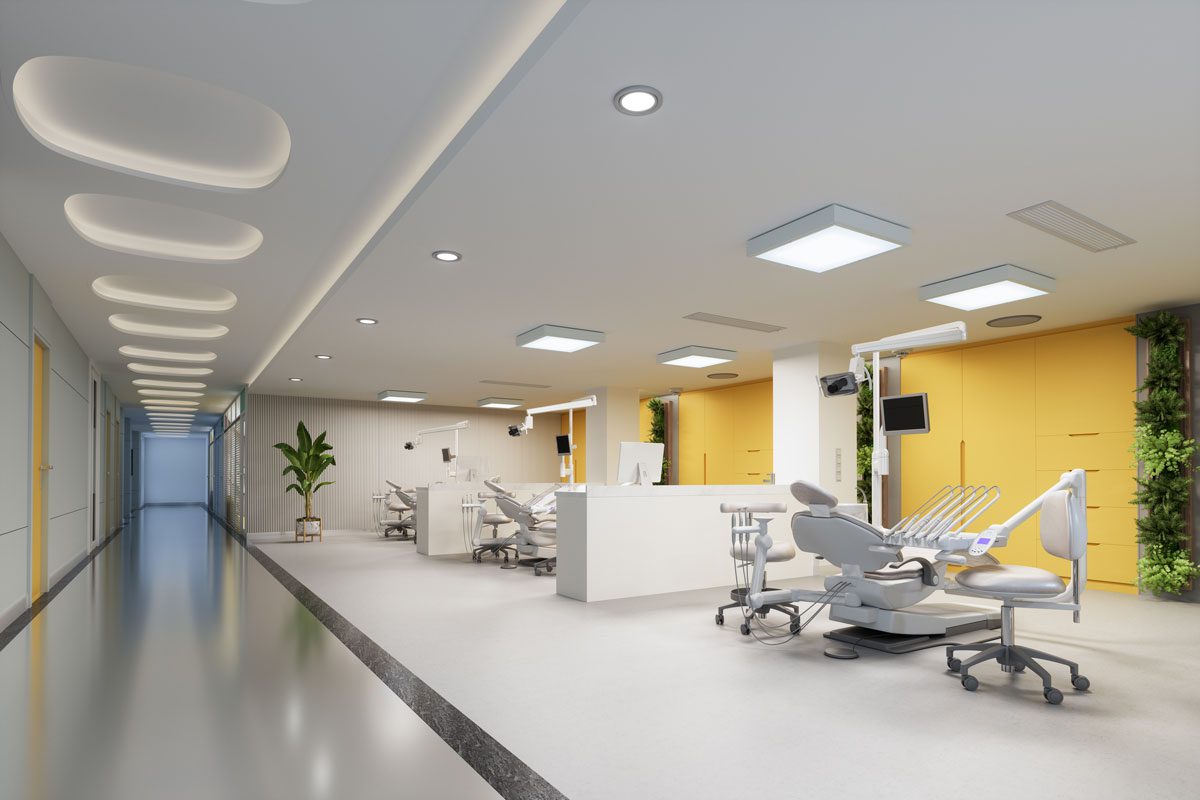What is a good dental office design? Why does it matter?
A good dental office design is crucial in creating a comfortable and welcoming environment for patients and staff. It can help enhance the overall patient experience while reflecting the dental practice's brand and values. A well-designed space can improve workflow and productivity and contribute to the practice's long-term success.
One essential aspect of dental office design is using colors that promote a calm and soothing atmosphere while maintaining cleanliness and professionalism. According to the American Dental Association, choosing the right color scheme is vital for a successful design. Moreover, incorporating modern technology, ergonomic furniture, and innovative layouts are integral to creating an efficient and patient-friendly dental practice, as discussed by Goetze Dental.
Beyond aesthetics, a good dental office design should also optimize the patient experience. This can be achieved through strategies such as placing hygiene supplies in easily accessible locations, ensuring privacy during consultations, and designing waiting areas that cater to patients' comfort and well-being, as Benco Dental recommends.
What is a Good Dental Office Design? Focus on Functionality and Efficiency
A well-designed dental office incorporates functionality and efficiency to provide an exceptional patient experience and a smooth workflow. Critical aspects of creating a functional and efficient dental office include dental equipment layout, sterilization and storage, and patient flow and accessibility.
Dental Equipment Layout
Designing a practical dental equipment layout ensures all necessary tools and machinery are easily accessible and organized, minimizing wasted time and movement. A thoughtful layout aligns with the clinical workflow, reduces clutter, and promotes efficiency.
For example, placing frequently used tools near the dental chair or having a designated area for dental instruments can streamline the workflow and reduce stress for dental professionals.
Sterilization and Storage
Maintaining proper sterilization and storage protocols is critical for a well-functioning dental office. A well-designed sterilization area should have separate zones for receiving, cleaning, sterilizing, and storing dental instruments (Dental Economics).
This separation helps prevent cross-contamination and ensures a clean and organized workspace. Efficient storage solutions, such as modular cabinetry and adjustable shelving, can optimize space utilization and grant easy access to supplies and instruments.
Patient Flow and Accessibility
Smooth patient flow and accessibility are crucial components of a functional dental office design. Breaking the space into distinct zones like public, clinical, and team zones can improve the flow and organization of the clinic. Benco Dental has an excellent white paper that takes a deep dive into the process.
Examples of optimizing patient flow include:
-
- Having separate entrances and exits for patients and staff to minimize congestion.
- Designing spacious, well-lit hallways and waiting areas for patients, ensuring they feel comfortable throughout their visit.
- Positioning dental operatories near each other, which can assist in promoting collaboration among dental professionals.
Design Aesthetics
When it comes to creating a good dental office design, aesthetics play a significant role in making the space inviting and comfortable for patients and efficient for dental practitioners. Careful consideration of the color scheme, lighting, artwork, and decorations can create a desirable atmosphere for patient experience and staff productivity.
Color Scheme
Choosing the right color scheme directly impacts the overall feel and mood in a dental office.
Light and neutral colors, such as white, beige, and soft pastels, are typically preferred to create a sense of cleanliness and calmness.
Incorporating accents of bolder and cooler colors, like blues and greens, can provide a touch of energy and continuity to the space. It is essential to balance a soothing color palette and one that effectively represents the dental practice's brand identity.
Lighting
Proper lighting design is essential to a well-functioning dental office, as it can influence both mood and visibility.
Natural light is most desirable for enhancing the office's openness and relaxation. Large windows and skylights not only provide an abundance of natural light but can also help reduce energy consumption.
As for artificial lighting, consider using accent lighting to emphasize specific areas within the office, such as reception desks or treatment areas. Additionally, incorporating modern light fixtures can contribute to the overall contemporary design aesthetics of the dental office.
Artwork and Decorations
When selecting artwork and decorations, it is important to consider pieces that enhance the visual appeal of the office while maintaining a professional atmosphere.
Subtle yet engaging artwork, such as nature-inspired prints or abstract paintings, can add interest and depth to the walls. Including sculptures or other three-dimensional elements can add an artistic touch to the overall aesthetic (Goetze Dental). Locally sourced artwork is always a good choice, reinforcing your connection with the local area.
Furthermore, incorporating decorative plants and greenery can improve air quality and create a welcoming and soothing patient environment. Be sure to choose low-maintenance plants that can thrive in an indoor office setting.

What is a Good Dental Office Design? Key in On Patient and Staff Comfort
Waiting Area
A well-designed waiting area is essential for a comfortable dental office experience.
It should provide patients with a relaxed environment where they can feel at ease before their appointment. Plus-sized seating options, comfortable chairs with armrests, and benches can accommodate various preferences and family sizes.
Additionally, incorporating personal touches, such as artwork or articles, can create a more welcoming atmosphere and help patients feel more connected to their dentist.
Ergonomic Furnishings
In a dental office, ergonomic furnishings are crucial for the patients and the dental team.
This includes chairs and equipment that provide support and reduce the risk of strain or discomfort during long patient sessions. Some practices offer adjustable-height chairs and equipment, ensuring that both patients and staff have a comfortable working environment.
Acoustics and Noise Control
Implementing effective noise control measures can greatly improve a dental office's comfort and patient experience. One patient's adverse reactions to pain or treatment can affect the mood of the entire office.
This may include using sound-absorbing materials like acoustic ceiling tiles and partition walls to separate noisy areas, like dental equipment rooms, from patient treatment areas. Adequate noise control can create a more peaceful environment for patients and staff, positively affecting their overall experience and well-being.
Sustainability and Eco-Friendly Design
In recent years, sustainability and eco-friendly design have become increasingly important aspects of a good dental office design. This approach benefits the environment and contributes to the practice's overall success by attracting environmentally-conscious patients and showcasing the eco-friendly values of the dental team.
Energy Efficiency
Energy-efficient dental offices focus on reducing their carbon footprint by using energy-saving technologies and practices.
For instance, installing LED lighting and energy-efficient HVAC systems can result in substantial energy savings. Additionally, transitioning to fully electronic systems can reduce paper waste, as seen in a UK private dental practice that swapped their vehicle parking spaces for bicycle racks to reduce the carbon footprint of patient and staff travel.
Water Conservation
Dental offices consume a significant amount of water daily, making water conservation a crucial aspect of eco-friendly design.
Practices can invest in water-saving technology, such as low-flow fixtures and dental equipment designed to minimize water usage. Regular maintenance and timely repair of leaks can also contribute to a more sustainable dental office.
Eco-Friendly Materials
Choosing eco-friendly materials for constructing and furnishing a dental office plays a significant role in creating a sustainable space.
For example, using environmentally-friendly cabinetry free of added urea-formaldehyde and organic bamboo and organic cotton fabrics for chair covers can minimize harmful chemicals in the office. Additionally, selecting biodegradable ceiling and wall panels can further enhance the eco-friendliness of the dental practice.
Integrating sustainability and eco-friendly design into a dental office not only demonstrates a commitment to environmental protection but also fosters trust, loyalty, and an increase in business, as Kappler Design has noted. By incorporating energy efficiency, water conservation, and eco-friendly materials into the practice, dental offices can create a comfortable and caring environment for patients and staff.

Innovative Technology and Equipment
Incorporating innovative technology and equipment into a dental office design can enhance the patient experience, improve diagnostic accuracy, and streamline office procedures. This section highlights three important sub-categories: Digital Technology, Telecommunication and Networking, and Advanced Dental Equipment.
Digital Technology
Digital technology has revolutionized how dental practices operate, enabling better patient care and overall efficiency.
Incorporating digital imaging systems, such as digital X-rays and intraoral cameras, provide clearer images and quicker diagnoses. These tools can easily integrate with practice management software, facilitating seamless data transfer, storage, and collaboration among dental team members.
Another critical digital technology is the dental CAD/CAM system.
It allows for more accurate and efficient design and fabrication of dental restorations, such as crowns and bridges. These systems contribute to more precise dental treatments, faster turnaround times, and a better patient experience.
Telecommunication and Networking
Effective telecommunication and networking in a dental office help improve patient outreach and office management.
A robust phone system that includes call routing, voicemail, and call forwarding facilitates seamless communication between staff and patients. Additionally, investing in a reliable and high-speed internet connection is essential for efficient office operation and communication among team members. (And keeps patients happy in the waiting room while they are using their mobile devices!)
Another aspect of networking to consider is the integration of office management software, which streamlines the scheduling, billing, and documentation processes. This software can combine with digital dental records to securely store patient information and simplify record-keeping.
Advanced Dental Equipment
Advanced dental equipment is essential in delivering high-quality patient care, and integrating these cutting-edge tools into your dental office design will elevate your practice. Examples include:
-
- Dental lasers for a wide range of treatments, such as cavity preparation, gum contouring, and teeth whitening
- 3D printers for creating dental models and restorations
- Advanced dental chairs with integrated technology for patient comfort and treatment efficiency
Incorporating innovative technology and equipment in your dental office design creates an environment that maximizes efficiency, improves patient care, and positions your practice for success.
Compliance with Regulations and Standards
A good dental office design should comply with important regulations and standards.
Adherence to these rules helps ensure the safety and well-being of both patients and staff while also lending credibility to the practice. One of the most important requirements is the Occupational Safety and Health Administration (OSHA) regulations.
OSHA provides guidelines that address various workplace hazards commonly found in dental practices. Some key areas to focus on during office design include proper ergonomics, radiation exposure, and waste management.
Integrating ergonomic design is essential to minimize the risk of musculoskeletal disorders among dental professionals. Proper workstations, adjustable chairs, and well-placed equipment can help achieve an ergonomic setup. Employing low-dose digital radiography reduces radiation exposure risk, while appropriate waste management systems ensure the safe disposal of hazardous materials.
In addition to OSHA, dental offices must also comply with the Health Insurance Portability and Accountability Act (HIPAA). A dental office design should consider HIPAA regulations to protect patient privacy.
For example, strategically positioning reception and consultation areas away from waiting areas can limit the disclosure of patient information. Additionally, secure storage and locked cabinets for physical files and password-protected electronic systems are necessary.
Infection control is another significant concern, particularly concerning the COVID-19 pandemic. A good dental office design should integrate infection control measures, such as clear signage for handwashing and sterilization procedures, appropriately positioned hand sanitizing stations, and designated areas for donning and doffing personal protective equipment.
Lastly, it is essential to consider accessibility requirements under the Americans with Disabilities Act (ADA). Dental office design should ensure that all patients, including those with disabilities, can access facilities conveniently. This may involve features such as ramps, wider doorways, and accessible restrooms.
Asking what is a good dental office design? We hope all of these tops and sources help you get started.
Good luck!




